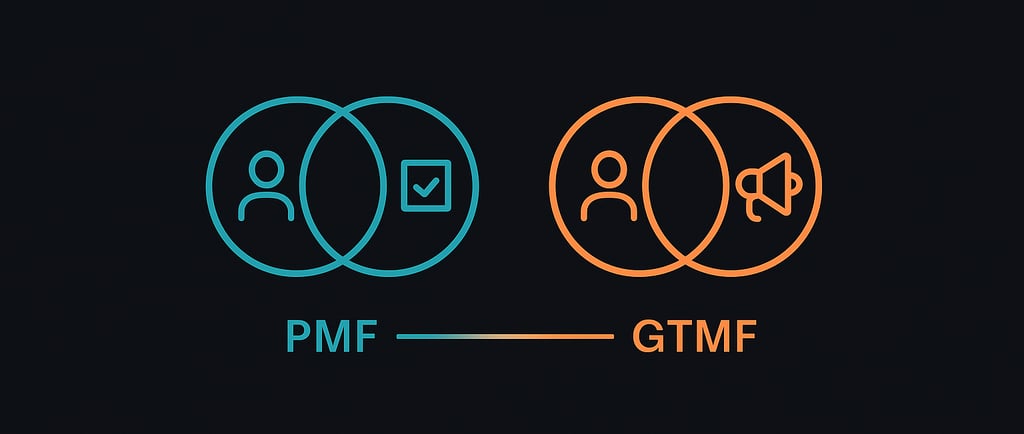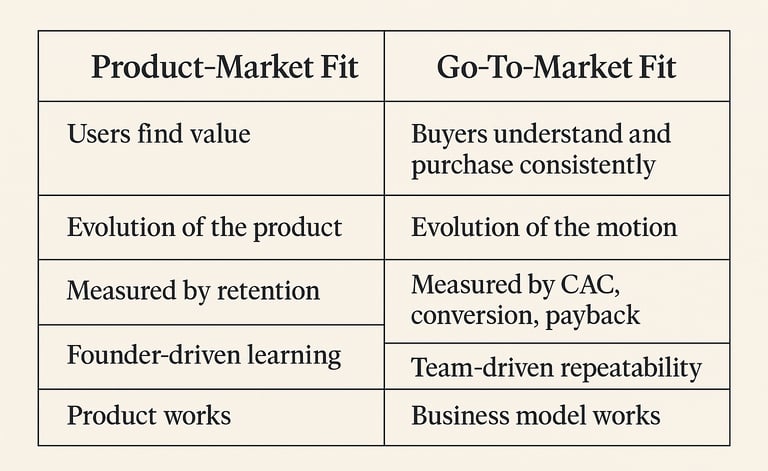Product-Market Fit vs Go-To-Market Fit: The Missing Sequence Slowing Down Most B2B SaaS Teams
SAASGROWTH
11/25/20255 min read


If your SaaS company feels stuck, the issue is rarely your marketing channel or your sales process. It is almost always a misalignment between what your product delivers and how your company sells it. Teams that understand the difference between Product-Market Fit and Go-To-Market Fit make better decisions, run cleaner experiments, and scale with far fewer mistakes.
Here is a straightforward way to diagnose where you stand and what to prioritize next
1. What Product-Market Fit Actually Means
Product–Market Fit (PMF) is the point where your product reliably solves a meaningful problem for a specific customer segment. It is not early hype or a few positive demos. PMF shows up in repeatable user behavior.
HubSpot’s analysis highlights that retention, repeat usage, and willingness to pay are the strongest indicators that your product is delivering value to the right audience. Most early SaaS teams underestimate how consistent these patterns need to be.
You are moving toward PMF when:
Users reach the core value quickly
Retention stabilizes across early cohorts
Customers expand usage or add new teams
Users refer the product without being prompted
Buyers pay without heavy negotiation
Teams that reach PMF usually commit to clarity. They choose a single ICP, understand a real pain, and design a focused solution that produces a meaningful outcome for that specific group.
How to measure PMF
Activation and engagement
Cohort retention
Frequency of the core action
NPS and qualitative feedback
Referral activity
The “How disappointed would you be if this disappeared” survey
For most early SaaS products, strong retention means at least 30 to 40 percent of users stay active by day 30 in a self-serve model, or at least 70 percent logo retention in a sales-led cycle. For the disappointment survey, 40 percent or more answering “very disappointed” is a reliable PMF signal.
PMF is the foundation. Without it, no marketing or sales effort can scale sustainably.
2. What Go-To-Market Fit Means
Once your product delivers consistent value, the next milestone is proving you can acquire and retain customers in a repeatable way. This is Go-To-Market Fit (GTM Fit).
PMF lives inside the product. GTM Fit lives in your motion. It is the system that attracts, converts, and retains your ideal customer.
You are approaching GTM Fit when:
Your ICP is validated
Messaging resonates with both users and decision makers
Channels generate a qualified pipeline consistently
Demo to close rates become predictable
CAC payback is healthy
Sales no longer depend on the founder
A healthy CAC payback for early-stage SaaS is usually under 12 months, and ideally under 9 months for SMB or mid-market. Messaging resonance shows up as higher demo booking rates, stronger reply rates, and better opportunity to close conversion.
GTM Fit does not come from random experiments. It is built through clarity around ICP, positioning, pricing, buyer journeys, and disciplined execution.
How to measure GTM Fit
Consistent pipeline creation
Higher win rates
Predictable sales cycles
Improving CAC payback
Strong retention and expansion
Conversion gains across the funnel
Many early founders struggle at this stage because they try to scale too soon. This is where Briskfab often supports teams by refining ICP, tightening messaging, mapping buyer journeys, and building the first repeatable GTM motion.
3. PMF vs GTM Fit: The Differences That Matter
Here is the simplest way to understand the distinction:


PMF alone leads to stalled growth.GTM Fit alone leads to churn.
You need both, and you need them in the right order.
4. The Common Mistakes Early Teams Make
Even experienced teams make predictable mistakes that slow their progress.
1. Scaling sales before PMF
Hiring SDRs or AEs too early creates inconsistent results and frustrated teams.
2. Outsourcing marketing before strategy
Without clarity on ICP and messaging, execution becomes scattered and inefficient.
3. Trying to fix GTM problems with more features
Most sales issues come from positioning or segmentation, not missing functionality.
4. Using signups as the north star
Signups show curiosity. Retention shows value.
5. Targeting a broad ICP
A wide audience weakens messaging, slows learning, and harms conversion.
Avoiding these mistakes accelerates both PMF and GTM Fit.
5. A Simple Diagnostic to Know Where You Stand
Here is a practical way to self-assess your stage.
You likely have PMF if:
One segment shows strong adoption
Users return without being pushed
Word of mouth starts appearing
Strong adoption usually means activation in the 40 to 60 percent range and consistent retention across multiple early cohorts.
You likely have GTM Fit if:
Deals close consistently within a defined ICP
Pipeline becomes stable
Sales cycles and conversion rates improve predictably
You likely have neither if:
Leads do not convert
Churn is high
Sales cycles feel random
Messaging does not land
Growth depends entirely on the founder
This diagnostic alone helps early teams avoid months of misalignment.
6. What to Fix Based on Your Stage
If you have PMF but weak GTM Fit
Shift your focus to defining ICP, sharpening messaging, tightening pricing, building a basic playbook, and improving your funnel systematically.
If you have early GTM signs but weak PMF
Slow down. Strengthen onboarding, shorten time to value, return to user interviews, and improve the core experience.
If you have neither
Start with customer understanding and positioning. Everything else depends on clarity here.
High-performing teams do not try to fix everything at once. They diagnose accurately and act with intention.
Conclusion
Product–Market Fit makes your product worth using. Go-To-Market Fit makes your company worth scaling. Both matter, and they matter in sequence.
Once you understand this distinction, decision-making becomes simpler, your experiments become sharper, and your growth journey becomes far more predictable.
If you want support in diagnosing your stage and building the right momentum, Briskfab works closely with early-stage companies to bring clarity to their GTM motion and scale with confidence. Book a free GTM and PMF audit today!
FAQs
1. Why do SaaS teams confuse Product–Market Fit with Go-To-Market Fit?
Because early traction can look the same on the surface. Signups, demos, and positive feedback feel like momentum, but only retention and repeated value delivery confirm PMF. GTM Fit comes later, when you can turn that value into a predictable acquisition and conversion motion.
2. What is the simplest way to check if we actually have PMF?
Look at behavior.bIf users reach the core value fast, come back consistently, expand usage, and pay without long negotiations, you’re close.
If you need to push, remind, incentivize, or “keep users alive,” you’re not there yet.
3. What is the simplest way to check if we have GTM Fit?
Ask whether your pipeline, conversion rates, and payback look predictable and repeatable.
If different reps can follow the same process and close the same type of customer, you’re moving toward GTM Fit.
4. Can we skip PMF and build the GTM engine directly?
No. You can generate pipeline without PMF, but you can’t scale it. Everything breaks later – churn rises, CAC spikes, sales cycles stretch, and you end up rebuilding the motion anyway.
5. What should we do if we’re unsure whether the problem is PMF or GTM Fit?
Check retention first. If users don’t stay, don’t expand, or don’t reach value, fix the product experience. If retention is healthy but acquiring and converting customers is messy, focus on ICP, messaging, pricing, and the sales motion.
6. Why does the sequence matter so much?
Because without PMF, GTM efforts turn into expensive experiments. Without GTM Fit, PMF becomes isolated success that never scales. Teams grow faster and with less friction when they fix PMF first and GTM Fit second.
